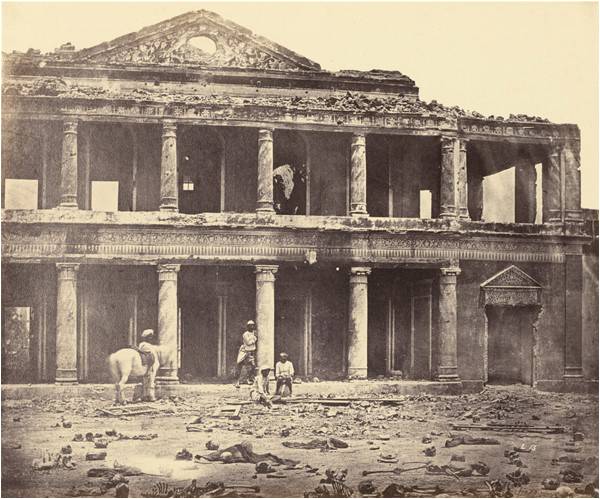
Felice Beato’s ‘Interior of Secundra Bagh after the Massacre’ in Lucknow is one of the first known photographs to show real corpses.
Beato travelled around India photographing the sites of the rebellion in 1858. He is famed for having documented the “Indian Mutiny” and its aftermath. The rebellion received widespread coverage in European media, and Beato was hired by the War Office in London to document the effects of the fighting.
Shocking at the time, this image depicts human bones strewn in the courtyard of the ruined Secundra Bagh palace after 2,000 Indian rebels were killed. The story goes that the Bengalese soldiers feared that their foreign employer was trying to force Christianity upon them by violating their cultural taboo. They had purportedly been issued rifle cartridges lubricated with pork and beef lard, which was in violation of Hindu and Muslim laws. In defense of their beliefs, the soldiers attacked an English garrison and colony at Cawnpore. The British retaliated in November 1857, and the scattered bones of some of the 2,000 rebels killed were intentionally left unburied in the courtyard. Some claim that British soldiers had buried all the bodies and that Beato uncovered them in order to strengthen the dramatic effect of the photograph. Most scholars however, believe that the bones were still exposed when Beato arrived at the site, and that he simply rearranged them in order to fit his vision. Either way, the image’s graphic nature completely changed the way journalists approach the documentation of violent conflicts.
Beato travelled around India photographing the sites of the rebellion in 1858. He is famed for having documented the “Indian Mutiny” and its aftermath. The rebellion received widespread coverage in European media, and Beato was hired by the War Office in London to document the effects of the fighting.
Shocking at the time, this image depicts human bones strewn in the courtyard of the ruined Secundra Bagh palace after 2,000 Indian rebels were killed. The story goes that the Bengalese soldiers feared that their foreign employer was trying to force Christianity upon them by violating their cultural taboo. They had purportedly been issued rifle cartridges lubricated with pork and beef lard, which was in violation of Hindu and Muslim laws. In defense of their beliefs, the soldiers attacked an English garrison and colony at Cawnpore. The British retaliated in November 1857, and the scattered bones of some of the 2,000 rebels killed were intentionally left unburied in the courtyard. Some claim that British soldiers had buried all the bodies and that Beato uncovered them in order to strengthen the dramatic effect of the photograph. Most scholars however, believe that the bones were still exposed when Beato arrived at the site, and that he simply rearranged them in order to fit his vision. Either way, the image’s graphic nature completely changed the way journalists approach the documentation of violent conflicts.

